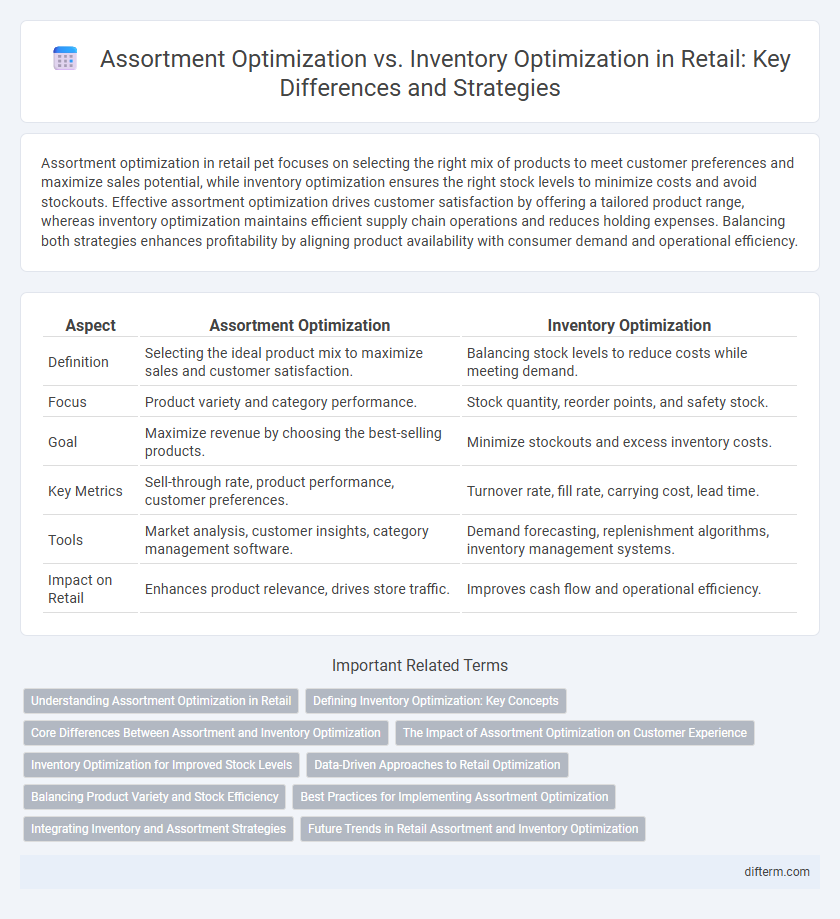Assortment optimization in retail pet focuses on selecting the right mix of products to meet customer preferences and maximize sales potential, while inventory optimization ensures the right stock levels to minimize costs and avoid stockouts. Effective assortment optimization drives customer satisfaction by offering a tailored product range, whereas inventory optimization maintains efficient supply chain operations and reduces holding expenses. Balancing both strategies enhances profitability by aligning product availability with consumer demand and operational efficiency.
Table of Comparison
| Aspect | Assortment Optimization | Inventory Optimization |
|---|---|---|
| Definition | Selecting the ideal product mix to maximize sales and customer satisfaction. | Balancing stock levels to reduce costs while meeting demand. |
| Focus | Product variety and category performance. | Stock quantity, reorder points, and safety stock. |
| Goal | Maximize revenue by choosing the best-selling products. | Minimize stockouts and excess inventory costs. |
| Key Metrics | Sell-through rate, product performance, customer preferences. | Turnover rate, fill rate, carrying cost, lead time. |
| Tools | Market analysis, customer insights, category management software. | Demand forecasting, replenishment algorithms, inventory management systems. |
| Impact on Retail | Enhances product relevance, drives store traffic. | Improves cash flow and operational efficiency. |
Understanding Assortment Optimization in Retail
Assortment optimization in retail focuses on selecting the ideal mix of products to maximize sales and meet customer preferences, balancing variety and depth across categories. It uses data analytics to identify high-demand items, seasonal trends, and regional preferences, ensuring shelf space is efficiently allocated. Unlike inventory optimization, which manages stock levels and replenishment, assortment optimization centers on product selection and positioning to drive store performance and customer satisfaction.
Defining Inventory Optimization: Key Concepts
Inventory optimization involves balancing stock levels to meet customer demand while minimizing holding and shortage costs, enhancing overall supply chain efficiency in retail. It incorporates demand forecasting, safety stock calculation, and reorder point determination to prevent overstocking and stockouts. Effective inventory optimization relies on real-time sales data analysis and dynamic replenishment strategies to maintain optimal inventory turnover rates.
Core Differences Between Assortment and Inventory Optimization
Assortment optimization focuses on selecting the right mix of products to meet customer demand and maximize sales, utilizing data on consumer preferences, trends, and competitive analysis. Inventory optimization prioritizes maintaining optimal stock levels to minimize holding costs and prevent stockouts, relying on forecast accuracy, lead times, and replenishment strategies. The core difference lies in assortment optimization addressing product variety and appeal, while inventory optimization targets quantity and availability management.
The Impact of Assortment Optimization on Customer Experience
Assortment optimization directly enhances customer experience by tailoring product offerings to meet diverse preferences and local demand patterns, resulting in higher satisfaction and increased sales. Effective assortment strategies reduce stockouts and overstock situations, ensuring customers find desired items more consistently. Retailers leveraging data-driven assortment optimization see improved loyalty and competitive advantage through more personalized shopping experiences.
Inventory Optimization for Improved Stock Levels
Inventory optimization enhances retail stock levels by balancing demand forecasts with supply chain capabilities, reducing overstock and stockouts. It uses data-driven techniques such as real-time inventory tracking and predictive analytics to maintain optimal product availability. Effective inventory optimization leads to improved cash flow, minimized holding costs, and increased customer satisfaction through consistent product availability.
Data-Driven Approaches to Retail Optimization
Data-driven approaches to retail optimization leverage advanced analytics and machine learning to enhance assortment and inventory management. Assortment optimization focuses on selecting the right mix of products to maximize sales and customer satisfaction, using customer preferences and sales data. Inventory optimization ensures stock levels align with demand forecasts and supply chain constraints, minimizing costs and preventing stockouts or overstock.
Balancing Product Variety and Stock Efficiency
Assortment optimization strategically selects a diverse range of products to meet customer preferences and drive sales, while inventory optimization ensures efficient stock levels to minimize holding costs and avoid stockouts. Balancing product variety and stock efficiency involves analyzing sales data, demand patterns, and supplier lead times to align inventory investment with consumer demand. Retailers achieve higher profitability by integrating these approaches, reducing excess inventory and improving product availability.
Best Practices for Implementing Assortment Optimization
Implementing assortment optimization in retail requires leveraging data-driven insights to align product selection with customer preferences and market trends, ensuring a balanced mix of high-margin and high-demand items. Effective collaboration between inventory management and merchandising teams enhances demand forecasting accuracy, reducing overstock and stockouts. Utilizing advanced analytics tools to continuously refine product assortments based on sales performance and regional preferences maximizes profitability and customer satisfaction.
Integrating Inventory and Assortment Strategies
Integrating inventory and assortment strategies in retail drives higher sales and reduces stockouts by aligning product selection with optimal stock levels. Advanced data analytics refine assortment choices based on consumer demand patterns while maintaining inventory turnover efficiency. This synchronized approach enhances customer satisfaction and maximizes profitability through precise inventory allocation and tailored product mixes.
Future Trends in Retail Assortment and Inventory Optimization
Future trends in retail assortment and inventory optimization emphasize leveraging AI-driven analytics to predict consumer demand more accurately and automate stock replenishment. Integration of omnichannel data sources enhances real-time visibility across inventory locations, enabling dynamic assortment adjustments tailored to regional preferences and seasonal shifts. Advanced machine learning models are increasingly used to optimize product mixes, reducing overstock and stockouts while maximizing profitability and customer satisfaction.
assortment optimization vs inventory optimization Infographic

 difterm.com
difterm.com